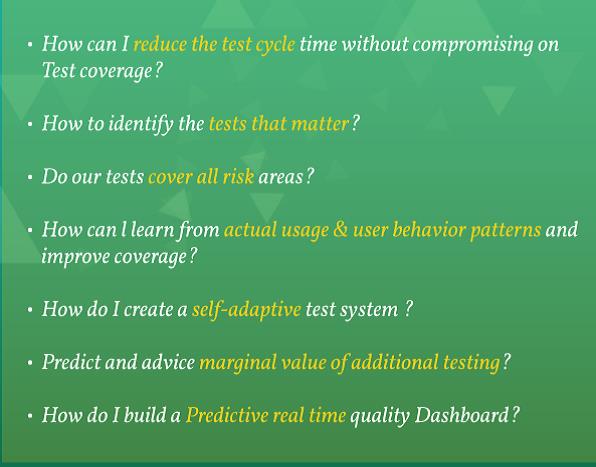ANALYTICS TO IMPROVE ENGINEERING AND OPERATIONS
December 19, 2018
I recently had the good fortune to be involved in the creation of the 2019 World Quality Report (WQR). Participating as an SME, I was called upon to give my inputs for the ‘Key trends in IT’ chapter of the report. This allowed me to take a sneak peek at the survey results on which the WQR is based, much before they were published. Having been in the Quality Assurance (QA) and testing field for over 20 years, this is something I look forward to every year, for this data often gives important insights into emerging trends in QA.
One of the new trends seen this year, was the use of analytics to drive optimization prior to automating test sets. To quote the WQR “According to our survey, 54% respondents said they were using analytics from project data to optimize test sets, while 45% stated they were using data from operations for optimization, and another 34% said they were using code coverage analytics. In addition, as many as 45% of our respondents said that they were using analytics and AI for intelligent automation of QA processes, 36% for predictive analytics, and 33% for creating self-learning, cognitive platforms.”

These findings also resonated with the results from a survey conducted by Forrester in 2016 on the same topic. Most of their respondents said they would like to apply analytics to automate the process of analyzing code, identify focus test areas, and predict outcomes.
A new trend or simply or simply an old one re-packaged?
Is this extensive use of Analytics a new trend? Actually, applying analytics to improve the way we do engineering and operations is nothing new. The first generation of analytics applications started in the 1950’s and matured through the 1980s within various systems engineering organizations. The second generation started with the implementation of statistical process control techniques by NASA, R&D efforts within AT&T and Nortel networks, empirical studies on data undertaken by Microsoft. They had an entire team of researchers working on data analytics to improve software development activities by late 2010.
Todays, analytics applications can be said to be a part of the third generation, which started from 2015, in the form of data science when several product engineering companies started adopting analytics and building analytical platforms to improve their engineering and operations. These companies included names such as General Electric and Google. At about the same time, the topic started being regularly mentioned in industry conferences and analyst circles.
As pointed out by the WQR, when it comes to QA, most organizations are still struggling with the following questions:

Analytics can help in each of these areas. At Capgemini, we have been applying analytics across several product engineering activities for customers with encouraging results and feedback. I will be discussing these use cases as well as some rules of the road, in my next blog post. In the meantime, if you have any questions/queries or want to explore opportunities for collaboration in greater depth, feel free to reach out to me at vivek.jaykrishnan@capgemini.com.

 English | EN
English | EN 